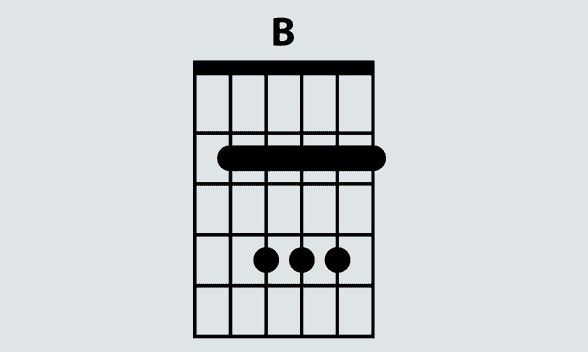Learning the B major chord may require more practice compared to other beginner chords due to its unique finger placement, but it is a crucial chord to master since it is commonly used in numerous songs.
This article provides a comprehensive guide on playing the B Major chord. While it may require more effort to learn compared to other beginner chords due to its unique fingering, mastering this chord is essential as it is widely used in numerous songs. Additionally, we will explore variations of the chord and provide tips on how to effectively learn it.
Contents
HOW TO PLAY THE B CHORD
2nd position
The B Major chord can be played in two common ways, both of which are barre chords and require challenging finger placement. Unlike other beginner chords such as C, A, G, E, and D that involve open strings, the B chord requires you to fret every note in the chord, resulting in the need for extra finger strength and effort. The first method involves playing the B Major chord in the 2nd position, which is illustrated as follows:
- Index finger on the 2nd fret of the A (5th) string
- Middle finger on the 4th fret of the D (4th) string
- Ring finger on the 4th fret of the G (3rd) string
- Pinky on the 4th fret of the B (2nd) string
- Strum four strings down from the A string.
7th position
Another popular way to play the B Major chord is in the 7th position, which can be achieved by following the finger placement illustrated below:
- Index finger on the 7th fret of the low E (6th) string
- Index finger on the 7th fret of the E (2nd) string
- Index finger on the 7th fret of the G (1st) string
- Middle finger on the 8th fret of the G (3rd) string
- Ring finger on the 9th fret of the A (5th) string
- Pinky on the 9th fret of the D (4th) string
- Strum all six strings from from the low E string.

Other versions
Playing the B Major chord in the 2nd position can be challenging due to the strength and stamina required to fret the notes close to the nut. This position is considered difficult, similar to the F Major chord, especially on an acoustic guitar.
If you’re struggling with this version, there are alternative ways to play the B Major chord that require less effort. One option is to remove your index finger from the 5th string and place it on the 1st string instead, resulting in a modified chord shape.
- Index finger on the 2nd fret of the E (1st) string
- Middle finger on the 4th fret of the D (4th) string
- Ring finger on the 4th fret of the G (3rd) string
- Pinky on the 4th fret of the B (2nd) string
Even without the B note in the bass, this version still maintains a full sound. However, if it’s still too challenging, we can simplify it further to give your wrists and fingers some relief. Here’s an alternative version that adds a touch of extra flavor and sounds wonderful on an acoustic guitar:
- Index finger on the 2nd fret of the A (5th) string
- Ring finger on the 4th fret of the D (4th) string
- Pinky on the 4th fret of the G (3rd) string
To play this chord, strum down from the A string, skipping the low E string. It’s actually a Bsus4 chord, and the 2nd and 1st strings will ring out, adding a touch of extra color. This version is easier to finger compared to the previous one and has a slightly more open sound. You can use this variation to bring variety and spice to your playing when you feel tired of the standard B versions.
The 3-note version
There are two 3-note versions of the B chord that you can use if you want to simplify it further. Here’s the first one:
- Index finger on the 2nd fret of the E (1st) string
- Ring finger on the 4th fret of the G (3rd) string
- Pinky on the 4th fret of the B (2nd) string
- Strum three strings down starting on the G string
Here’s another 3-note version of the B chord:
- Index finger on the 8th fret of the G (3rd) string
- Index finger on the 7th fret of the B (2nd) string
- Middle finger on the 7th fret of the E (1st) string
EXERCISES FOR PLAYING B CHORD
Once you have mastered the fingering for the B chord, it’s important to practice transitioning to and from it to solidify your skills. This chord is commonly found in songs in the key of E. One effective practice method is to transition between an E chord and a B chord, as well as between an A chord and a B chord. For example, play an open E chord for four beats, then switch to the B chord in the 2nd position for four beats, and finally return to the E chord.
Don’t let the fact that the two main ways to play a B chord require extra finger strength discourage you from learning it. It’s recommended to start with easier chords like E, C, or G if you haven’t already. Once you have those chords down, you will have developed enough finger strength and dexterity to tackle the B chord. If you’re struggling, remember that there are alternate versions of the B chord that sound just as good and are easier to play.
If you’re interested in learning more about music scales, chords, and musical theory, visit our Guitar tunio today
